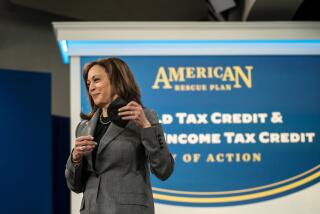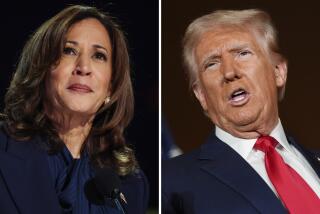Taxes Flatten but Deep Pockets Still Bulge
WASHINGTON — A decade ago, when publishing magnate Steve Forbes ran for president, he vowed to deliver a new era of prosperity with a simple change in the federal income tax: Instead of people with more money paying higher rates, all would pay the same “flat” tax rate -- unleashing “the fantastic growth waiting to burst forth in our economy.”
Forbes’ flat-tax plan was dismissed as simplistic by many mainstream economists and viewed with horror by the legions of special interests that benefit from the deductions and loopholes that flat-tax advocates would eliminate.
But as millions of Americans face the deadline for filing their federal tax returns, they are operating in something very close to the world Forbes and other flat-tax visionaries proposed. Without any fanfare or philosophical debate, millionaires and middle-class Americans now pay taxes at almost the same rates.
So what about the “fantastic growth waiting to burst forth”? Has leveling out federal income tax rates produced a cornucopia of financial benefits?
The answer is probably yes -- if you’re a millionaire. And probably no -- if you’re almost anyone else. Flattened, and thus lower, tax rates have contributed to huge increases in the wealth of the wealthy, but so far most people haven’t seen significant economic improvement.
“It’s as if Santa Claus dropped bags of money down everybody’s chimney,” said Leonard E. Burman of the private Tax Policy Center. “Only he dropped extra-big bags in rich people’s homes, and extra-small ones in smaller homes.”
Though most pay at least somewhat less in taxes than they did a few years ago, the Federal Reserve Board, in its latest three-year examination of family finances, found that average family income fell by 2% between 2001 and 2004 after adjusting for inflation. In the previous three-year period, average family income grew by 17%.
Thanks to more credit card debt and borrowing against their homes, the 25% of Americans at the bottom of the wealth scale had negative net worth in 2004. On average, these families owed $1,400 more than their possessions were worth.
The idea that income tax rates should be graduated, with those who had more money paying a larger share of it in taxes, was a fundamental premise of the federal income tax system when it was created by constitutional amendment in 1913 on the eve of World War I.
The first federal tax code specified a maximum rate of 7%, but after the U.S. entered the war in 1917, Congress boosted the top rate to 77%. During World War II, the top rate hit an astonishing 94%. As recently as 1980, the maximum rate on investment income was 70%, although the top rate on wages was 50%.
The tax cuts engineered by President Reagan lowered the top rate for all income to 50%, and the 1986 tax overhaul brought the top rate to 28% in 1988, its lowest level since 1931. But that lasted only until 1990, before deficit-reduction packages gradually lifted it to 39.6%.
Taxes have had an intimate and often stormy relationship with America’s economy and its politics since colonial days. In response to the British Sugar Act in 1764, which put duties on a range of foreign goods brought into the colonies, patriot leader Samuel Adams wrote: “If taxes are laid upon us in any shape without our having a legal representation where they are laid, are we not reduced from the character of free subjects to the miserable state of tributory slaves?”
If Adams had lived to see the rates imposed during the two world wars, he might have tried to start another revolution.
Under Forbes’ largely forgotten flat-tax proposal, taxpayers would have paid 17% in taxes on all income beyond $36,000 a year, excluding pensions and profits from the sale of investments. The system was to be so simple, the candidate said, that most taxpayers would fill out a form the size of a postcard.
No such system was adopted or even seriously considered, but President Bush has achieved something close to the flat-rate structure by cutting tax rates on earned income and particularly on dividends and investment profits.
Although the top tax rate is 35%, nobody pays that percentage in total because it applies only to income beyond the first $326,450. At the other end of the income scale, the lowest rate -- 10% -- applies only to the first $7,300 in income.
And then there is the regressive effect of the payroll tax, which finances Social Security and Medicare. Social Security’s share of the tax -- 6.2% -- applied last year only to the first $90,000 in wages. People who earned more than that paid a smaller percentage of their income in payroll taxes than did those who earned less.
As a result, people with income between $500,000 and $1 million owed the same share of their income in combined federal income and payroll taxes -- 22% -- as did taxpayers reporting at least $1 million in income, according to the Tax Policy Center.
Taxpayers in the $100,000 to $200,000 range paid nearly the same rate, 20.6%. Those in the $50,000 to $75,000 range paid 17.4%; taxpayers in the $40,000 to $50,000 range paid 15.8%; and those in the $30,000 to $40,000 range paid 13.6%.
Advocates of the flat tax have long argued that it would stimulate economic activity, ultimately benefiting everyone. Bush shares that view, though he has not officially advocated a flat tax.
In recent years, lower tax rates do seem to have aided economic growth. The economy has been producing goods and services at a rising pace since the end of the 2001 recession. Unemployment is a low 4.7%.
But the health of the economy as a whole has not translated into gains for most workers. Because of global competition, the decline of manufacturing, weaker labor unions, immigration and other factors, most workers have not been able to obtain higher pay.
Instead, flatter income tax rates have contributed to an economic landscape that David Kelly, economic advisor for Putnam Investments, likens to an hourglass. Some from the traditional middle class are rising into the top, but others are being squeezed out into the bottom.
Average family net worth has continued to grow, in large part because of rising home prices, but at a rate that sagged from 29% between 1998 and 2001 to 6% between 2001 and 2004. And for most Americans, whatever nominal pay increases they got in the last three years were more than offset by higher costs of things such as healthcare.
Meantime, the disparity between the wealthiest Americans and everyone else has grown.
Last year, for example, a typical corporate chief executive made 279 times the average pay of a non-supervisory production worker, according to the liberal Center for American Progress.
That figure, the second-highest in 40 years, was up from 229 in 2004 and 185 in 2003.
Measured another way, during the previous seven economic expansions before the current one, employee compensation rose four times faster than corporate profits, according to the labor-supported Economic Policy Institute. In the current expansion, profits have risen three times faster than compensation.
The wealthy usually send more dollars to Uncle Sam than middle-income taxpayers do, because their rates are applied to a bigger income. But the share of their income that goes to Washington is not much bigger.
The failure of flattened tax rates to deliver greater rewards to the mass of workers helps account for why polls show Americans are so sour about the economy.
Maria Bautista of Concord, Calif., who took part in a recent Los Angeles Times/Bloomberg poll, said that the economy was performing “fairly well,” but that she paid too much in taxes.
“The rich absolutely do not pay enough in taxes,” said Bautista, an assistant special-education teacher. “There are less and less in the middle; either you make it big or you get left behind.”
*
(BEGIN TEXT OF INFOBOX)
A flatter tax
The average percentage of their income that people paid in combined federal income and payroll taxes in 2005:
*--* Income What people actually paid (In thousands of 2005 dollars) Less than $10 2.3% $10-20 3.7 $20-30 9.1 $30-40 13.6 $40-50 15.8 $50-75 17.4 $75-100 18.9 $100-200 20.6 $200-500 21.5 $500-1,000 22.0 Over $1,000 22.0
*--*
*
Source: Tax Policy Center
More to Read
Sign up for Essential California
The most important California stories and recommendations in your inbox every morning.
You may occasionally receive promotional content from the Los Angeles Times.










